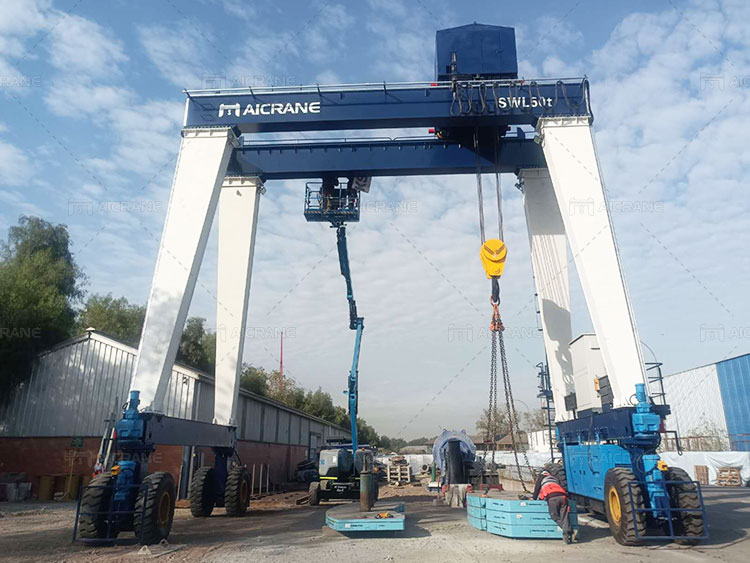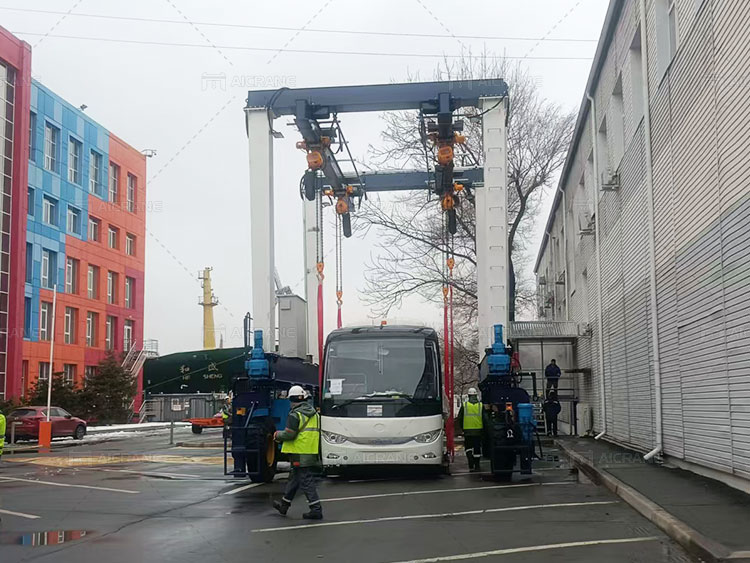When selecting the right steering mode for your wheeled gantry crane, there are several critical factors to consider. Wheeled gantry cranes are pivotal in industries such as container handling, shipyards, and construction, where high mobility and precise maneuvering are essential. The steering mode you choose can directly impact the crane’s efficiency, maneuverability, safety, and even its operational costs. In this article, we will explore the various steering modes available for wheeled gantry cranes, how they affect crane performance, and the key factors to consider when choosing the most suitable steering mode for your operation.
What Are Wheeled Gantry Cranes?
A wheeled gantry crane is a type of mobile gantry crane equipped with wheels for high mobility and flexibility in movement. Unlike traditional rail-mounted cranes, these cranes can be driven around the job site, making them ideal for environments where quick setup, repositioning, and handling of heavy loads are necessary. Wheeled gantry cranes are commonly used in ports, shipyards, construction sites, and storage facilities. These cranes come with various steering modes, allowing operators to customize their movements for optimal performance.

Key Steering Modes for Wheeled Gantry Cranes
There are several steering modes available for wheeled gantry cranes, each designed to address specific operational needs. The most common steering modes include:
-
Single-Axle Steering
-
Description: In single-axle steering, the crane’s front or rear wheels steer the crane, with only one axle providing the directional control. This mode is the simplest and most traditional.
-
Best For: Single-axle steering is typically used for smaller cranes or in spaces where the crane does not need to make sharp turns. It is commonly seen in less congested environments or when the crane will travel long, straight paths.
-
Advantages: Simple design, cost-effective, lower maintenance costs.
-
Limitations: Limited maneuverability, longer turning radius, less suitable for tight spaces.
-
-
Two-Wheel Steering
-
Description: In two-wheel steering, both the front and rear wheels of the rubber gantry crane can steer, but they steer in the same direction. This mode is more agile than single-axle steering and improves maneuverability.
-
Best For: This steering mode is ideal for moderate-sized cranes and applications where operators need a balance between maneuverability and stability. It is common in container terminals and other medium-scale operations.
-
Advantages: Increased maneuverability, reduced turning radius compared to single-axle steering, better stability at higher speeds.
-
Limitations: Less maneuverable than multi-wheel steering systems.
-
-
Four-Wheel Steering
-
Description: Four-wheel steering allows all four wheels to steer the crane, providing excellent maneuverability. The front and rear axles can either steer in the same direction for stability or in opposite directions for tight turning radii.
-
Best For: Four-wheel steering is perfect for environments where space is limited, such as busy ports, container yards, or congested construction sites. It allows the mobile gantry crane to make sharp turns and move in confined spaces.
-
Advantages: Highly maneuverable, tighter turning radius, better control in tight spaces.
-
Limitations: Can be more complex and expensive to maintain compared to single- or two-wheel steering systems.
-
-
Crab Steering
-
Description: Crab steering, a variant of four-wheel steering, allows all four wheels to steer in the same direction simultaneously, making the crane move laterally or sideways. This is useful when precise positioning of heavy loads is required.
-
Best For: Crab steering is ideal for situations where the crane needs to move sideways into or out of tight spots or between obstacles, such as in storage yards or warehouses.
-
Advantages: Precision control, ability to move sideways without changing the crane’s orientation, excellent for confined areas.
-
Limitations: Less suitable for high-speed operation, requires more complex control systems.
-
-
Multi-Steering (Diagonal Steering)
-
Description: In multi-steering or diagonal steering, each wheel of the crane can be independently controlled, allowing the crane to move diagonally across a job site. This mode provides the highest level of flexibility and control over the crane’s movement.
-
Best For: Multi-steering is used for large-scale operations that require frequent maneuvering in tight and complex spaces. It is often used in large warehouses, ports, and shipyards.
-
Advantages: Superior maneuverability, ability to make complex movements, very precise load handling.
-
Limitations: Requires advanced control systems and higher maintenance costs.
-
Factors to Consider When Choosing a Steering Mode
The right steering mode for your wheeled gantry crane depends on several factors, including the operational environment, load requirements, and long-term costs. Here’s how to evaluate your options:
1. Space and Site Conditions
-
Tight Spaces: If your operations take place in a constrained area with limited space for movement, then steering modes like four-wheel or crab steering are ideal. These systems reduce the turning radius and allow the crane to maneuver through narrow aisles or around obstacles.
-
Wide Open Areas: If the overhead gantry crane will primarily operate in open areas or along long paths, single- or two-wheel steering may suffice. These modes offer less maneuverability but are effective in larger, less congested environments.
2. Load Handling
-
Heavy Lifting: For cranes that will be handling heavy loads, stability becomes a priority. In these cases, four-wheel steering or two-wheel steering with a focus on stability may be preferred, as they provide a stable base for lifting operations.
-
Precision Lifting: If your crane is designed for precision tasks, such as moving sensitive or delicate loads, crab or multi-steering modes may be the best option. These modes allow for fine control over the crane’s position, making it easier to maneuver loads into precise locations.
3. Operational Speed
-
High-Speed Operations: For tasks that require high speed or travel over long distances, simpler steering systems such as single- or two-wheel steering might be more appropriate. These systems are easier to maintain and do not require the complexity of multi-steering modes.
-
Slow and Steady: If the crane is designed for slow, controlled movements—such as in heavy-duty lifting operations—then a more advanced steering system like four-wheel steering or crab steering would be ideal for greater control.
4. Maintenance and Operational Costs
-
Simple Steering Systems: Single- and two-wheel steering systems are typically simpler and less costly to maintain. If budget is a significant concern and the crane does not need to operate in tight spaces, these systems may be sufficient.
-
Advanced Steering Systems: More complex systems like four-wheel and multi-steering modes generally have higher upfront costs and maintenance requirements. However, they may provide greater value in terms of operational flexibility and productivity, particularly for larger, more complex operations.
5. Operator Experience
-
Ease of Use: More advanced steering modes like multi-steering require skilled operators who are familiar with the controls and the movements of the crane. Training costs and operator familiarity should be considered when choosing a steering system.
-
Basic Operations: For simpler operations or less experienced operators, single- or two-wheel steering may be preferable due to their simpler controls.

Conclusion
Choosing the right steering mode for your wheeled gantry crane involves a careful balance between maneuverability, stability, cost, and operational needs. It’s crucial to consider the layout of your worksite, the nature of the loads you will be handling, your desired operational speed, and the long-term costs associated with maintenance and operator training. While advanced steering systems offer unparalleled flexibility and precision, simpler modes can be effective in less demanding environments.
In the end, the ideal steering mode is the one that provides the best combination of performance, safety, and cost-effectiveness for your specific crane operations. Make sure to consult with your crane manufacturer or supplier to assess the best solution for your needs and ensure the crane performs at its optimum level, providing both efficiency and safety on the job site.
